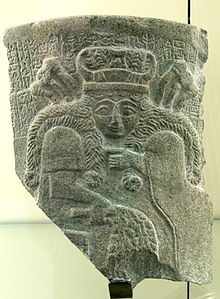Nisaba

Nisaba on a fragment of a vessel with the inscription of En-metena , ruler of Lagaš (around 2430 BC), Vorderasiatisches Museum Berlin
Nisaba is a Sumerian , Akkadian , Babylonian, and Assyrian goddess.
Nisaba was the daughter of Anus or Enlil (in Lagaš ). In the Neo-Sumerian and Old Babylonian times (end of the 3rd millennium / first half of the 2nd millennium BC) she was regarded as the wife of Haja , in the 1st millennium BC. Was assigned to her Nabu as husband. She was the sister of Nanše and Ningirsu . Originally, Nisaba was a Sumerian grain goddess. In the course of time she was assigned other functions. She thus became a goddess of penmanship, and thus automatically a goddess of sciences, including architecture. Their main shrines were in Umma and Ereš . In Aššur , Nisaba was venerated together with Šala and Ḫabiru in the Adad temple.
literature
- Helmut Freydank among others: Lexicon Alter Orient. Egypt * India * China * Western Asia. VMA-Verlag, Wiesbaden 1997, ISBN 3-928127-40-3 .
- Brigitte Groneberg : The gods of the Mesopotamia. Cults, myths, epics. Artemis & Winkler, Stuttgart 2004, ISBN 3-7608-2306-8 .
Individual evidence
- ↑ Otto Schröder : Cuneiform texts from Assur with different content. Leipzig 1920, II 8-11; Horst Klengel : The weather god of Halab . In: Journal of Cuneiform Studies 19, 1965, 93 note 60